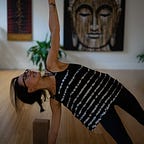Musings on yoga and inclusion: Part 1
During this seemingly endless twilight zone of the COVID-19 pandemic, yoga spaces have become more important than ever. Whether virtual or in-person, a yoga class can offer a much-needed pause, a moment to be with breath and body, a way to structure days that seem to meld into each other. For those who have a regular yoga practice, we may take the experience of taking a class — from finding the schedule, signing up, and paying, to entering the space, setting up your mat and props, and doing the practice — for granted. However, this experience of integrating practice into daily life is not universal — and that’s what this article is all about.
Yoga spaces, by their nature, should be inclusive. Yoga may be primarily a physical practice in the Western world (pranayama, asana, meditation), but it is rooted in a philosophy of connectedness: with self, others, and the universal. It is a beautiful, ancient practice that offers a lifetime of benefits for anyone: no matter what shape one’s yoga practice takes, it has the potential to prepare the body and mind for stillness, which is where its deep benefits begin. A regular practice builds resilience to move through life’s challenges, whether they are physical, emotional, or circumstantial — and I think we can all agree that 2020 has brought these challenges to the forefront.
Think about your first ever yoga class. Maybe you were convinced to tag along with a friend, or maybe you passed by a sign enticing you with ‘FREE YOGA FOR EVERYONE’ (that was my entry point). See if you can recall how it felt to enter the space. Did you know where to go? Were there stairs to climb? Was there clear signage? Was there an area where you could change and use the restroom? Was there a tap to fill your water bottle? Could you borrow a mat and props?
When you got into the practice room, did you know where to place your mat? Was the space quiet or full of voices? Did you feel calm or anxious? Did fellow students acknowledge your presence? Did the teacher introduce themself? Did they set expectations for the class?
When the class began, how did it feel to move? Did the instructor cue breath in a way that made sense to you? Did they offer variations of each asana? Did their verbal and/or physical adjustments help you find expressions of poses that felt good in your body? Did you feel pressure to achieve a certain shape? Was there an option to rest if you wanted to?
After class, did the instructor stick around to chat? Did you feel comfortable approaching them with questions? Was there a space to unwind before heading back into the world? Were there class schedules available so that you could plan your next visit? Most importantly, did you feel called to return to the space?
I know: so many questions.
But these are crucial questions to ask if we want yoga to be inclusive. We cannot assume that everyone has a positive experience in yoga spaces. And if we want yoga to truly be available to all, we need to untangle some of the aspects that detract from that positive experience. The unfortunate truth is that for many students, yoga spaces do not feel welcoming.
To gain insights into what building inclusion into yoga teaching looks like, I approached a few of my peers who teach movement and meditation in a way that intentionally invites people in, regardless of where they’re coming from. Their views on inclusion stem from their own experiences as practitioners, as well as their intention to foster supportive communities for students of different ages, abilities, and interests.
Thinking about how to make shapes that feel good — and that foster a calm and steady mind.
Please head over to Shut Up & Yoga to read on.
